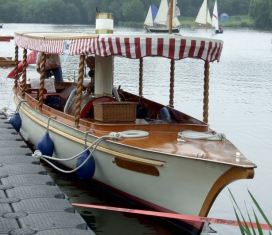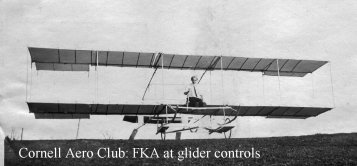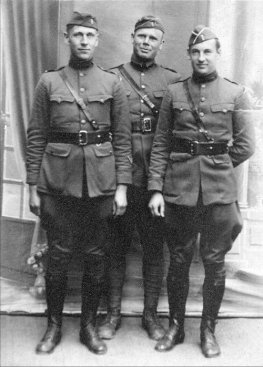Francis Kerr Atkinson 1890-1976: Some Biographical Notes
These notes have not been researched in any substantive way, being largely what I remember from reminiscences told to me during my childhood and from direct experience later.
 My grandfather George Francis Atkinson, after having graduated from Cornell University in 1885, held teaching positions in zoology at the University of North Carolina, later of botany at the University of South Carolina, and then at the Alabama Polytechnic Institute in Auburn. He had moved there with his wife Elizabeth Graham Kerr (“Lizzie” Kerr)—formerly of Raleigh, NC where her by then deceased father, Washington Carruthers Kerr, had been the State Geologist. A daughter, Josephine, was born but died in infancy.
My grandfather George Francis Atkinson, after having graduated from Cornell University in 1885, held teaching positions in zoology at the University of North Carolina, later of botany at the University of South Carolina, and then at the Alabama Polytechnic Institute in Auburn. He had moved there with his wife Elizabeth Graham Kerr (“Lizzie” Kerr)—formerly of Raleigh, NC where her by then deceased father, Washington Carruthers Kerr, had been the State Geologist. A daughter, Josephine, was born but died in infancy.
My father—Francis Kerr Atkinson—was born in Auburn, Alabama on the first of May, 1890.
In 1892 his father accepted an appointment at Cornell University as an assistant professor of botany and the family moved to Ithaca, New York where his sister Clara Packard Atkinson was born that year.
The family settled on the campus in a house at 5 East Avenue whose wooded backyard sloped steeply down to Cascadilla Creek. From visits in the late twenties I can remember the house which was eventually swallowed by the burgeoning engineering campus after WWII.
At the end of the nineteenth century the mix of public service technology then in Ithaca was interesting. There was no domestically distributed electricity, yet the telephone had arrived and a fully functioning electric street car utility served the town and the campus above. The automobile was a curiosity; all local transportation was by horse and carriage. Houses were piped with gas for lighting and cooking but central heating, such as it was, was hot-air and coal-fired. My father recalled arriving home to a dark house in winter whereupon his father would don slippers, turn on the gas and, after some diligent shuffling of feet on the carpet, touch his finger to the gas jet; lighted by the resulting electrostatic spark. A gas-fired “Geyser” in the bathroom heated water on demand but not without its dangers. One winter night while he basked in the bath his mother sensed that too long a time had passed and went to investigate. After having broken open the door she found him unconscious in the tub, victim of the Geyser’s stealthy coal-fired appropriation of the oxygen in the closed space.

At the age of five (1895) Kerr was witness to the tragic drowning of his maternal uncle, William Hall Kerr, a successful textile entrepreneur on whose naphtha launch Watauga the families were enjoying an excursion in Annapolis Harbor. Six year old Philip, one of the four small Kerr boys—my father’s first cousins—slipped overboard, and his father, who evidently could not swim, jumped after him. Others managed to rescue the boy, but the father drowned [1]. Kerr’s mother and his young sister Clara were also on board.
My father disliked the name Francis and took his middle name as his first: Kerr [pronounced “car”]. In his early years he attended “Miss Hitchcock’s” school on the Cornell campus along with other children of faculty families, most notably my mother who was almost the same age—Elsie Sterling Church, daughter of Professor Irving Porter Church of civil engineering. It was there—after a discussion of the children’s ages—that one child blurted out to the young Miss Hitchcock: “Gee, you must be a hundred”!—one of my father’s favorite anecdotes. Kerr and Elsie both later attended Ithaca High School from which my father graduated in 1907 and my mother in 1908. He and Elsie played the violin in the high school orchestra [2]; my father kept on with it for the rest of his life—all through my childhood he practiced in the dining room on Sunday afternoons—themes and melodies that have lasted in my memory to the present day.
 During his secondary school years he kept a small but elegant inboard motor launch on Cayuga Lake—the onomatopoetic “Rikki-Tikki-Tavi” after the sound of the engine. I have a series of photo’s of my youthful father off on a picnic in the boat with his family and their black cocker spaniel, Booker T. Washington; which says something about the times and my father’s Southern parental origins. He was always polite, fair, and deferential to Black people although never, I think, able completely to accept them as a natural part of his cultural and professional world.
During his secondary school years he kept a small but elegant inboard motor launch on Cayuga Lake—the onomatopoetic “Rikki-Tikki-Tavi” after the sound of the engine. I have a series of photo’s of my youthful father off on a picnic in the boat with his family and their black cocker spaniel, Booker T. Washington; which says something about the times and my father’s Southern parental origins. He was always polite, fair, and deferential to Black people although never, I think, able completely to accept them as a natural part of his cultural and professional world.
With the exception of an occasional vignette he never spoke in detail of his years as a boy and young man at home in Ithaca. He rarely mentioned his family or his sister Clara; an omission I never questioned until years later. Only near the end of his life did I learn from him that his parents had separated and divorced over his father’s alcoholism (probably around 1910) and, further, that his sister Clara had died, a suicide in 1917 in New York City [2]. He revealed these secrets to me with great emotion and I realized that they were born in a different cultural era where divorce and suicide were universally considered to be dark and shameful family failings.
 Clara was a talented artist all of whose work has been lost except for a clever bookplate designed for her brother when he was at Cornell.
Clara was a talented artist all of whose work has been lost except for a clever bookplate designed for her brother when he was at Cornell.
After the separation his father acquired a small rustic house in the woods and fields north of the campus at 138 Ridgewood Road that he called “Laurelwood”, where he lived and worked until his death in 1918. His mother moved to Manhattan with his sister Clara and, sometime after 1925, removed to Asheville, North Carolina where she died in 1952.
Kerr entered Cornell in 1907 and in 1912 graduated with a double degree in mechanical and electrical engineering. The engineering honor society Tau Beta Pi inducted him as a member. His classes in mechanics were taught by  Professor Church, his future father-in-law. This period was barely five years after the Wright Brother’s success in 1903 and my father—an early member of the Cornell Aero Club—was active in the designing and building of tethered gliders and towed machines which were tested and “flown” on the open heights to the east of the campus. Cornell (perhaps my father) built one of the earliest wind-powered flight trainers.
Professor Church, his future father-in-law. This period was barely five years after the Wright Brother’s success in 1903 and my father—an early member of the Cornell Aero Club—was active in the designing and building of tethered gliders and towed machines which were tested and “flown” on the open heights to the east of the campus. Cornell (perhaps my father) built one of the earliest wind-powered flight trainers.
Finished with university he immediately got a job in Schenectady with General Electric where, I think, he had had previous summer stints. He was there for more than a year and remembered having met and had exchanges with the eminent Nikola Tesla and Charles Steinmetz.
Eventually a Cornell friend, who was teaching in Missouri at the University in Columbia, invited my father to join him there. He accepted and spent three years as an instructor in electrical engineering during which time he broke his leg playing soccer and broke up with a serious lady friend. Asked why he didn’t stay in teaching he would say: “I could see an inescapable groove”—he meant a “rut”; he would indicate it with an undulating motion of his hand—“forming ahead of me.” He feared that teaching would be too narrowly restrictive and not sufficiently representative of the larger world where the important action lay.
 In June of 1916 Kerr began work in Wilkes-Barre Pennsylvania for the Lehigh Valley Coal Company where he began as assistant to the company electrical engineer. He told a story of a problem with a new electric traction locomotive which, when set up and ready to go, would not start on the advance of the conductor’s controller. He lay down next to the track close under the engine and asked the conductor to try it again, this time hearing a faint “click” on first contact. After some reflection he directed that the polarity of the connections on one of the two traction motors be reversed; and, lo, the locomotive started. He reminisced that, while lying close to the track in possible danger, it was fortunate that the two electrically mis-opposed motors had exactly balanced starting torques.
In June of 1916 Kerr began work in Wilkes-Barre Pennsylvania for the Lehigh Valley Coal Company where he began as assistant to the company electrical engineer. He told a story of a problem with a new electric traction locomotive which, when set up and ready to go, would not start on the advance of the conductor’s controller. He lay down next to the track close under the engine and asked the conductor to try it again, this time hearing a faint “click” on first contact. After some reflection he directed that the polarity of the connections on one of the two traction motors be reversed; and, lo, the locomotive started. He reminisced that, while lying close to the track in possible danger, it was fortunate that the two electrically mis-opposed motors had exactly balanced starting torques.
 One year later World War I overtook him and he enlisted in the American Expeditionary Force (AEF) as an engineer in the officer candidate program. He finished training at Fort Dix in 1917 as First Lieutenant and sailed to France in 1918 as commander of the 78th Division, 303rd Engineer Train “comprising 125 men, 100 mules, 25 wagons and 12 motor trucks.” They were part of the 78th “Lightning” Division. After slogging eastward across France supplying timber and hardware to the builders of bridges across the river Aire under fire and cover of night near Grand Pré they saw several weeks of active service before the November armistice.
One year later World War I overtook him and he enlisted in the American Expeditionary Force (AEF) as an engineer in the officer candidate program. He finished training at Fort Dix in 1917 as First Lieutenant and sailed to France in 1918 as commander of the 78th Division, 303rd Engineer Train “comprising 125 men, 100 mules, 25 wagons and 12 motor trucks.” They were part of the 78th “Lightning” Division. After slogging eastward across France supplying timber and hardware to the builders of bridges across the river Aire under fire and cover of night near Grand Pré they saw several weeks of active service before the November armistice.

After the Armistice Kerr’s unit was sent to wait out the return home in Venarey-les-Laumes where he was billeted with a French family, Chapeau, for the winter and spring of 1919. During this period he became attached to the young son Fernand Chapeau, then about ten, and, over many years, sent gifts at Christmastime and small sums to help with his education [3].
After the War he put together a small booklet “Mules and Motor Trucks in France”; a reminiscence and detailed history of the 303rd.

It was while he was in France that his father (George Francis Atkinson) died of the “Spanish” influenza [4] in Tacoma, Washington in November of 1918, interrupting a mushroom specimen gathering expedition in the vicinity of Mount Rainier. It is my impression that Kerr was given leave to attend the funeral in Raisinville, Michigan—which would have meant at least a month’s absence from his unit in France.
After the war Kerr returned to the Lehigh Valley Coal Co. where he remained until connecting with an old friend and fellow engineer, Roderick Donaldson, who had established a small consulting business in Manhattan and who sought a partner. In 1920 Kerr accepted a partnership and moved to New York City where he lived for several years at 502 West 113th Street.
As I have heard it, late in 1920 Kerr bumped into Elsie Church in the New York City subway. I suppose each must have known of the other’s presence in the city but hadn’t yet formally arranged to get together. Elsie had just taken a job at the Guaranty Trust after a summer of odd jobs at home in Ithaca. Following a springtime courtship they became engaged and were married in Cornell’s Sage Chapel on August 18, 1921. 
They honeymooned in France where they revisited Kerr’s Fernand Chapeau “family” in Venarey-les-Laumes; the son, Paul Debrion [5] of his mother’s godson in Clermont-Ferrand; Elsie’s Leandre Legal “family” in Hautvillers; and Elsie’s wartime AEF “canteen” village of Bay-sur-Aube.
Back in Manhattan Kerr and Elsie first lived in a small apartment on Tiemann Place on the Upper West Side, but by the spring of 1923 they were expecting a baby and had found a larger apartment at 502 West 113th Street in the same building where Kerr had lived with his mother before their marriage. Sadly, in July the child—a daughter—was stillborn.
Then, on January 13, 1925 I was born, as my mother liked to say, in “Hell’s Kitchen” where the hospital was located on the East Side in the forties.
Later that year Donaldson gave up his part in the consulting partnership and Kerr, who may have already entertained the idea of continuing on his own, gave that up after having received word from his first cousin Philip Kerr in Boston that his employer, the engineering consulting firm of Jackson & Moreland, was hiring. It was Phil who had been saved from drowning in 1905.
And so in October our family arrived in Boston, and by way of a night in the Beaconsfield Hotel—where, I am told, I spent the night in a bureau drawer—we settled into a second floor apartment in Brookline at 27 Claflin Road on Aspinwall Hill. Kerr began what was to become a successful twenty-five year career at Jackson & Moreland where he soon became a project manager directing the design and construction of electrical power generating plants, oil refineries, and industrial facilities.
On March 1st 1926 my sister Elizabeth Holley Atkinson was born in N.E. Baptist Hospital.
To be continued?
References:
[1] The press of the Wm. J. C. Dulany Co. of Baltimore published a small monograph entitled “William Hall Kerr” containing notes on the funeral services, a biographical sketch , and details of this accident.
[2] Clara Packard Atkinson (1892-1917) died in New York City, a suicide.
[3] After a search I was able to find his son Pierre, a mason, in Venary where I visited on two occasions.
[4] The “Spanish flu” pandemic killed 20 million people worldwide and 550,000 in the United States.
[5] Paul’s father, Henri Debrion, was (un filleul de guerre) of Kerr’s mother—as un poilu killed in a tragic military rail accident in 1917.
Also: A recent search for the traces of Paul Debrion by Les Poilus de Madrid.
William C. Atkinson, November, 2017
